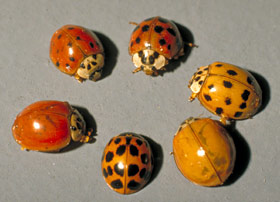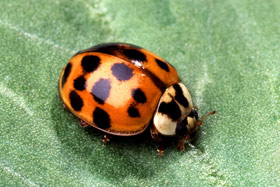Multicolored Asian Lady Beetle, Harmonia axyridis

Multicolored Asian lady beetle showing color variations. Photo by Bill Ree, Texas A&M University, Bugwood.org.
IPM Steps to reduce Multicolored Asian Lady Beetles
1. Sample for Pest
Where to find it while inspecting: When gathering in fall, they will be found in large numbers on the sunny side of buildings and trees. Any available access to protected habitat may encourage large numbers to enter for overwintering. Look for gaps and holes in structure, most notably around eaves, windows and foundations (again, often on the south side of the building).
2. Proper ID
Size and Particulars: Up to 3/8", more oval than round. Colors vary as does spotting. (Can be yellow to red, with spots or without, spots are not always black.) Look for a W or M on the proturnum: “back of head”.
3. Learn the Pest Biology

Multicolored Asian lady beetle adult. Photo by Scott Bauer, USDA Agricultural Research Service, Bugwood.org.
Life Cycle: Overwintering adults emerge from hibernation to lay orange colored eggs in groups of 12 on plants with pest activity—most often eggs are laid on plants with aphid activity. Larvae have four instars (molts) and pupate without a cocoon under leaves.
Preferred Food Sources: Plant material and egg, larvae, nymphs or adults of other insects. Lady beetle larvae are extremely effective at managing other insect pests.
Preferred Habitat: Plant material where other insects are a food source (most often plants with aphids). Multicolored Asian lady beetles overwinter in large groups and as such are considered a pest when they invade buildings in the fall. Warm winter days prompt activity and lady beetles will often appear in sunny windows and warmer areas of the building.
4. Determine Threshold
Threshold: While the occasional visitor is not a problem, large numbers of lady beetles inside a structure can cause allergy problems in sensitive individuals, and these in particular are known to bite. They do not carry diseases or harm building materials. Act to isolate or prevent access inside building by sealing cracks and gaps.
5. Choose Tactics
Best Management Practices: Exclusion is the safest, most effective way to reduce or prevent lady beetle invasion. Caulk around window frames, outdoor faucets, vents. Fill holes with mesh and caulk, add rubber or brush sweeps to doors (including roll down doors), keep window screens in good repair, screen inside around vents.
Treatment Methods: Wash outside of building with dish soap around areas of entry for lady beetles to discourage scent tracking. Sticky tape or boards may be used in some circumstances near entry areas to reduce numbers. Vacuum clusters with shop-vacs (lady beetles may leave an odor in the hose), or collect live beetles and keep in a cool area with water drops added 1x week until spring when insect activity has begun outside—release as beneficial insects (daytime temps averaging near 55 degrees).
6. Evaluate
Was the tactic successful? Record the date pests were first noted, and the tactic you used, and its success. Use one of our RECORD KEEPING tools.
For More Information
Ladybug, Ladybug, Fly Away from My Home!
Remember:
When a pesticide application is necessary, all necessary and required precautions are taken to minimize risk to people and the environment and to minimize risk of pesticide resistance or pest resurgence. Pesticide use in your school may be prohibited or regulated by local policies or state and federal regulations. Risk reduction methods can include, but are not limited to, spot-treatment, the use of gel or paste bait formulations placed in inaccessible locations, injection into a crack or crevice, and other methods that reduce potential exposure.